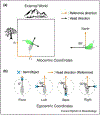Egocentric and allocentric representations of space in the rodent brain
- PMID: 31794917
- PMCID: PMC7080648
- DOI: 10.1016/j.conb.2019.11.005
Egocentric and allocentric representations of space in the rodent brain
Abstract
Spatial signals are prevalent within the hippocampus and its neighboring regions. It is generally accepted that these signals are defined with respect to the external world (i.e., a world-centered, or allocentric, frame of reference). Recently, evidence of egocentric processing (i.e., self-centered, defined relative to the subject) in the extended hippocampal system has accumulated. These results support the idea that egocentric sensory information, derived from primary sensory cortical areas, may be transformed to allocentric representations that interact with the allocentric hippocampal system. We propose a framework to explain the implications of the egocentric-allocentric transformations to the functions of the medial temporal lobe memory system.
Copyright © 2019 Elsevier Ltd. All rights reserved.
Conflict of interest statement
Declaration of interests
The authors declare that they have no known competing financial interests or personal relationships that could have appeared to influence the work reported in this paper.
Figures




References
-
- O’Keefe J, Nadel L: The Hippocampus as a Cognitive Map. Oxford: Clarendon Press; 1978.
-
- Hafting T, Fyhn M, Molden S, Moser M-B, Moser EI: Microstructure of a spatial map in the entorhinal cortex. Nature 2005, 436:801–806. - PubMed
-
- McNaughton BL, Leonard B, Chen L: Cortical-hippocampal interactions and cognitive mapping: A hypothesis based on reintegration of the parietal and inferotemporal pathways for visual processing. Psychobiology 1989, 17:230–235.
Publication types
MeSH terms
Grants and funding
LinkOut - more resources
Full Text Sources

